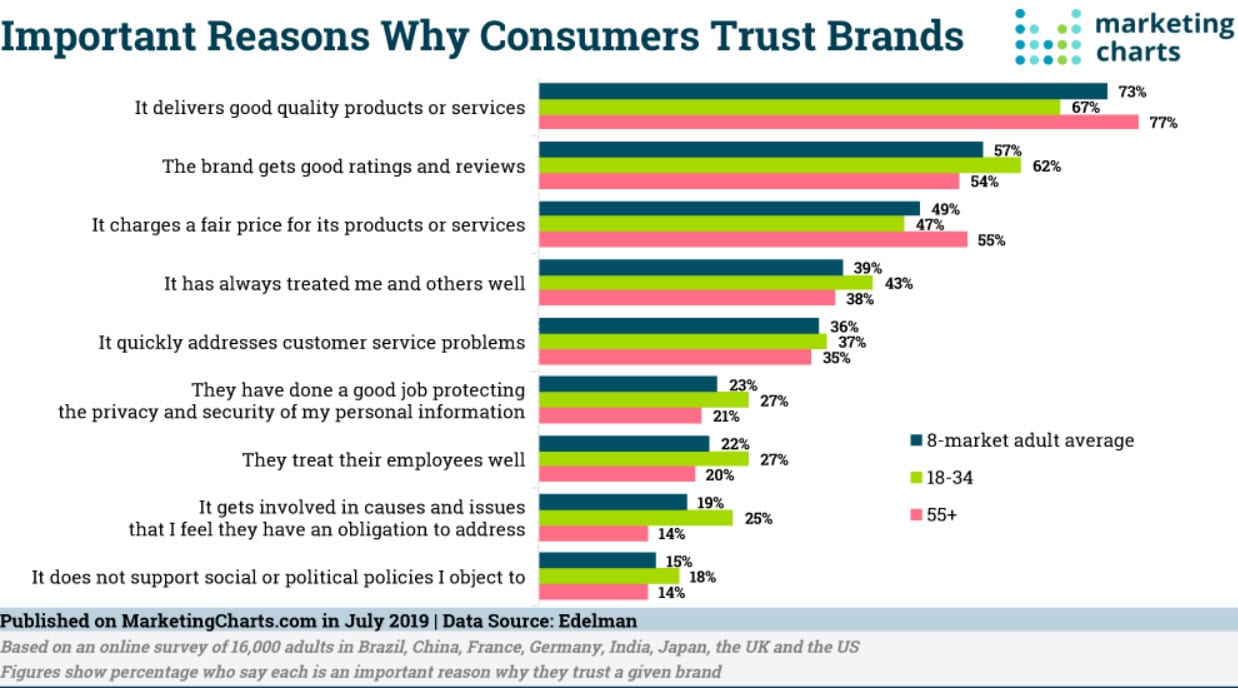Your brand is your calling card. It defines what you’re known for as a company, and makes you memorable in consumers’ eyes. Building your brand should be high on your list of marketing priorities, and brand marketing can help.
We break down what brand marketing is, the goals you should set for brand marketing, and the seven essential steps in the entire process.
What is a brand?
When you think of brand, you likely think of the logo, slogans, colors, and visuals associated with a company. However, in the 21st century, your brand isn’t just your name, slogan, and logo.
Today, brand encompasses much more. Your brand is your company’s overall identity, built by several factors, including the ones below:
- Your company mission, vision and values
- What you offer and accomplish as a company (your products and services, your customer service, the quality of these )
- Benefits of turning to your company vs. your competitors
- Your messaging, including your slogan and brand story
- Your voice/tone (this is your personality, or how you speak as a brand)
- The imagery you use (your brand colors and logos, as well as any pictures you use in marketing)
- Your brand reputation (how the public sees your company, and what they say about you)
Now that we’ve defined what brand is, let’s dive into defining brand marketing.
What is brand marketing?
Brand marketing is any marketing centered on communicating your brand identity.
Since brand identity is so broad, brand marketing is not just about slapping your logo anywhere you can. Rather, it’s about sharing all aspects of who you are as a company, especially your mission and values.
Since brand marketing feeds your overall goals for how you represent yourself, brand marketing strategy is focused on the long term rather than the short term.
We will cover some types of marketing tactics that fall under brand marketing later in this article.
Brand marketing goals
What are the objectives of brand marketing strategy? Here’s the rundown.
The most well-known goal of brand marketing is to get your audience to instantly think of your mission and messaging whenever they see your logo or products. It’s all about building brand awareness and making a memorable logo with brand’s characteristics.
A good way to do this is by creating visually attractive logos to better convey your brand positioning and personality.
Differentiating your brand from competitors, so consumers have a solid reason to choose you, is another major objective. So is making your brand relatable – showing your human side, so people think of you as much more than just a corporation.
Brand marketing is also aimed at increasing your positive brand reputation. You might not be able to control what people say about your brand, but you can tip the scales in your favor by developing positive associations with your brand, and encouraging positive talk about you.
Encouraging your audience to associate your brand with positive emotional triggers is yet another brand marketing goal. Emotions are powerful – if your brand is associated with positivity, that’s another tool you have at your disposal.
Finally, promoting loyalty to your brand is a crucial part of brand marketing. Your existing customers are your best customers – they have a higher customer lifetime value, and loyal customers are more likely to refer their friends to your brand.
The importance of developing a solid brand identity
Why is establishing a solid brand identity (sometimes called brand equity) so vital?
Brand marketing helps boost your sales, because it gives current and potential customers a reason to choose your product over the competition.
- It builds trust in your brand by sharing values that resonate.
- And it helps your audience associate your product with quality and value.
Brand marketing is a vital part of reputation management.
- It helps shape how the public perceives your business, and lets you take some control of the narrative surrounding your brand.
Most importantly, brand marketing is vital to building brand loyalty – not just getting customers to come back, but convincing them to pick your product over the competition every time.
- People become loyal to a brand because of its overall identity, not just its products. Brand identity is the core reason people consistently choose Apple over Android or Coke over Pepsi. Coke and Pepsi are extremely similar on the surface (product level) but brand identity makes them drastically different in customers’ minds.
- Brand identity is also why people choose branded products over generic, “off-brand” versions. They see the brand name as more reliable and higher quality than the generic product, even though the generic one is usually cheaper.
- Loyal customers are more likely to refer your brand to their friends: They are your best advocates. These referring customers are a free, high-quality lead generation source because their friends trust what they have to say about your brand.
Essential components of marketing your brand
What do you need to do to develop solid branding? Follow these seven key steps.
1. Establish your brand mission, vision, values, and emotions: what is your brand about?
- What mission is at the cornerstone of everything you do? As an example, Patagonia’s mission statement is to “build the best product,” “cause no unnecessary harm,” “use business to protect nature” and fight against the climate crisis, and “not be bound by convention.” For more mission statement examples, check out this article from HubSpot.
- What values and characteristics do you want your brand to be known for? For example, Apple is known for innovation, exclusivity, and delivering features that loyal users want. Target is famous for high-quality products at a low price. TOMS is known for giving shoes, and other aid, to those in need, and standing for “a better tomorrow.”
- What feelings do you want people to attach to your brand? For instance, Red Bull is synonymous with high adrenaline adventure, and Coca-Cola always strives to be associated with happiness and joy.
2. Define your target audience and what motivates them.
The audience you want to target should be very specific.
Some examples of specific audiences include boys ages 6-12; female undergrad college students ages 18-22; millennial moms of infants under 1 year of age; or marketers age 25-40 who work at small to medium-sized B2Bs.
After you have a target audience, it’s time to develop buyer personas, or individual hypothetical “people” in your target audience with different motivations and shopping habits. This way you’ll be able to develop messaging that resonates with your target audience.
For instance, if you’re a baby brand targeting millennial moms of infants, one persona you might develop is: The confident, digital native mom with at least one other child, always looking to make daily tasks easier given her busy schedule, who appreciates environmental friendliness and socially-conscious brands, and who frequently turns to her network for product recommendations.
3. Establish your brand voice/tone, as well as its messaging.
Keep your target audience at the top of your mind when you make these decisions.
- What sort of tone will your brand use to communicate your mission and set of values to your audience?
- What sorts of messages will resonate with your audience, particularly your personas?
- What slogans will you use?
- Remember that messaging also includes visuals. What colors and images will you use to communicate your brand?
Wendy’s is a prime example of how to nail brand voice. The brand uses a witty, snarky, humorous tone to resonate with millennial and Gen Z audiences on Twitter, and communicate its commitment to fresh beef and other quality offerings, a clear step above other fast food. They regularly use their own takes on memes as visuals.
4. Choose your best channels.
You’ll want to communicate your identity across a variety of channels, but don’t spread yourself too thinly. In this digital age, it’s better to be strategic.
Focus on the channels that your audience frequents most, and figure out how best to communicate your brand based on the features of each channel.
For example, if your audience is on Twitter, you’ll need to use short messages that fit within the character limit.
5. Figure out how you will position yourself.
Establish the marketing techniques you will use to communicate your brand.
- How will you differentiate yourself from competitors?
- Will you use representatives? If so, what kind – influencers? ambassadors? affiliates?
- Will you position your brand as a solution to your audience’s problems and pain points?
- Will you focus on quality or uniqueness in a specific area?
- Will you use referral marketing, or other word-of-mouth marketing, to show that your brand is trusted among your audience’s peers?
6. Set measurable goals.
Like any marketing strategy, you’ll need a concrete way to measure the success of your brand marketing campaigns. Conversions, customer retention vs. churn, and customer lifetime value are solid KPIs to use to measure your success. Remember that you’ll be tracking success over the long term, since brand marketing is a long-term strategy.
7. Stay consistent.
Keep your branding consistent across all of your channels, so people aren’t confused about what you represent.
Your website, social media, blog, and all other mediums you use to market yourself should all have the same branding: convey the same mission, use the same messaging, and use the same imagery.
And be sure to stay consistent in your actions: embody your mission and values at all times.
Leave no room for doubt, because people will call you out negatively if you aren’t consistent, and likely damage your reputation. But when you are consistent, people will reward you with positive comments, and boost your reputation. This is the digital age – word travels fast. Do all you can to be sure that word is positive.
Conclusion
If you want a business to be successful, it’s important to think of it as a brand. By using our tips to grow your brand, your business can begin growing its customer base and enjoying lots of success.





